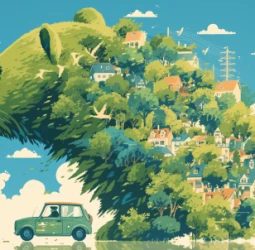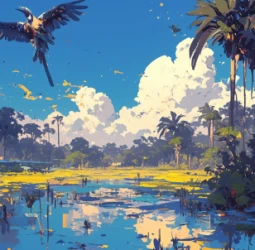The Amazon Rainforest, also known as the "lungs of the planet", is the largest and most biodiverse rainforest in the world. Covering over 2.1 million square miles and spanning nine countries, the Amazon is home to millions of plant and animal species, many of which are found nowhere else on Earth. Unfortunately, this precious ecosystem is under threat due to deforestation, making it crucial for conservation efforts to be taken in order to preserve this natural wonder.
In recent years, the Amazon Rainforest has suffered from significant deforestation, primarily due to agricultural expansion, logging, and illegal mining. This has caused irreparable damage to the ecosystem, leading to loss of biodiversity, displacement of indigenous communities, and a decline in the Earth's oxygen supply. As a result, conservation efforts have become essential to protect this vital ecosystem.
One country that has been at the forefront of conservation efforts in the Amazon is Brazil, which holds the largest portion of the rainforest. In 2004, the Brazilian government implemented the Action Plan for the Prevention and Control of Deforestation in the Legal Amazon, which aims to reduce deforestation rates to zero. This initiative has seen a significant decrease in deforestation rates, from nearly 30,000 square kilometers in 2004 to just over 7,000 square kilometers in 2019. This is a result of stricter laws and enforcement, as well as partnerships with local communities and organizations.
Furthermore, Brazil has also taken steps to monitor and protect indigenous territories within the Amazon. These areas are crucial for the preservation of the rainforest as they are home to indigenous communities that have lived in harmony with the land for centuries. The government has recognized the rights of these communities and has implemented measures to prevent illegal activities within their territories. This not only helps to preserve the rainforest but also protects the livelihoods and cultures of these indigenous communities.
In addition to government efforts, there are also numerous non-governmental organizations (NGOs) working towards the preservation of the Amazon. One such organization is the Amazon Conservation Team, which focuses on partnering with indigenous communities to protect their territories and biodiversity. They also work towards sustainable development in these communities, promoting the use of traditional knowledge and practices to preserve the rainforest.
However, despite these conservation efforts, the Amazon Rainforest still faces many challenges. The current government in Brazil has been criticized for weakening environmental policies and regulations, which could lead to an increase in deforestation. Additionally, the effects of climate change, such as droughts and wildfires, also pose a threat to the rainforest. Therefore, it is crucial for these conservation efforts to continue and for more support to be given to preserve the Amazon.
In conclusion, the Amazon Rainforest is a vital ecosystem that requires immediate and ongoing conservation efforts. Brazil, along with other countries in the region, has made significant progress in reducing deforestation rates and protecting indigenous territories. NGOs also play a crucial role in preserving the Amazon. However, it is the responsibility of every individual to support and contribute to these efforts, whether it be through sustainable choices in daily life or supporting organizations dedicated to the preservation of the rainforest. Only by working together can we ensure that the Amazon Rainforest continues to thrive for generations to come.
In recent years, the Amazon Rainforest has suffered from significant deforestation, primarily due to agricultural expansion, logging, and illegal mining. This has caused irreparable damage to the ecosystem, leading to loss of biodiversity, displacement of indigenous communities, and a decline in the Earth's oxygen supply. As a result, conservation efforts have become essential to protect this vital ecosystem.
One country that has been at the forefront of conservation efforts in the Amazon is Brazil, which holds the largest portion of the rainforest. In 2004, the Brazilian government implemented the Action Plan for the Prevention and Control of Deforestation in the Legal Amazon, which aims to reduce deforestation rates to zero. This initiative has seen a significant decrease in deforestation rates, from nearly 30,000 square kilometers in 2004 to just over 7,000 square kilometers in 2019. This is a result of stricter laws and enforcement, as well as partnerships with local communities and organizations.
Furthermore, Brazil has also taken steps to monitor and protect indigenous territories within the Amazon. These areas are crucial for the preservation of the rainforest as they are home to indigenous communities that have lived in harmony with the land for centuries. The government has recognized the rights of these communities and has implemented measures to prevent illegal activities within their territories. This not only helps to preserve the rainforest but also protects the livelihoods and cultures of these indigenous communities.
In addition to government efforts, there are also numerous non-governmental organizations (NGOs) working towards the preservation of the Amazon. One such organization is the Amazon Conservation Team, which focuses on partnering with indigenous communities to protect their territories and biodiversity. They also work towards sustainable development in these communities, promoting the use of traditional knowledge and practices to preserve the rainforest.
However, despite these conservation efforts, the Amazon Rainforest still faces many challenges. The current government in Brazil has been criticized for weakening environmental policies and regulations, which could lead to an increase in deforestation. Additionally, the effects of climate change, such as droughts and wildfires, also pose a threat to the rainforest. Therefore, it is crucial for these conservation efforts to continue and for more support to be given to preserve the Amazon.
In conclusion, the Amazon Rainforest is a vital ecosystem that requires immediate and ongoing conservation efforts. Brazil, along with other countries in the region, has made significant progress in reducing deforestation rates and protecting indigenous territories. NGOs also play a crucial role in preserving the Amazon. However, it is the responsibility of every individual to support and contribute to these efforts, whether it be through sustainable choices in daily life or supporting organizations dedicated to the preservation of the rainforest. Only by working together can we ensure that the Amazon Rainforest continues to thrive for generations to come.



 dev1
dev1















